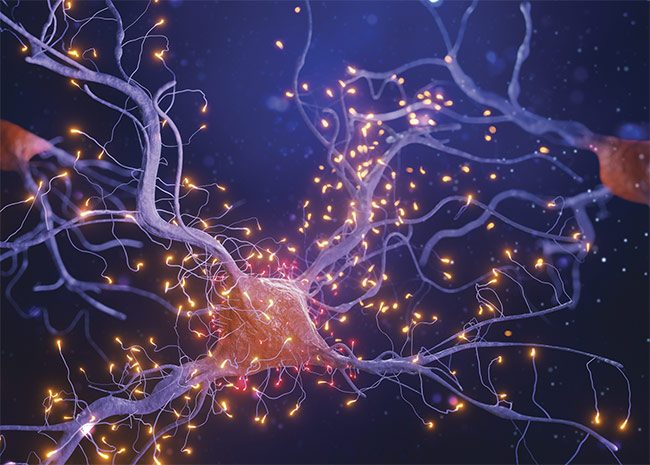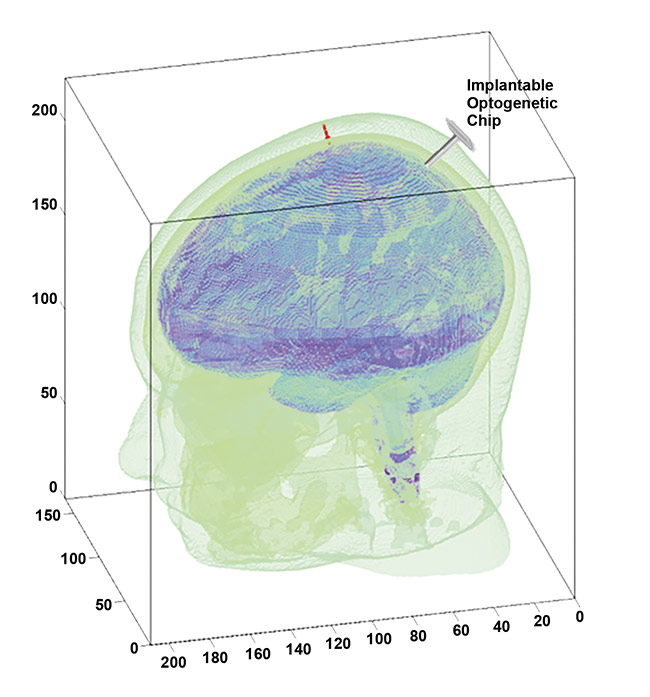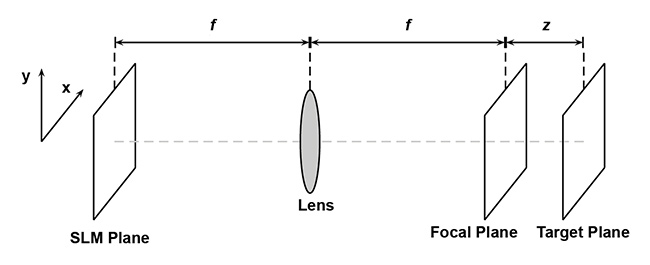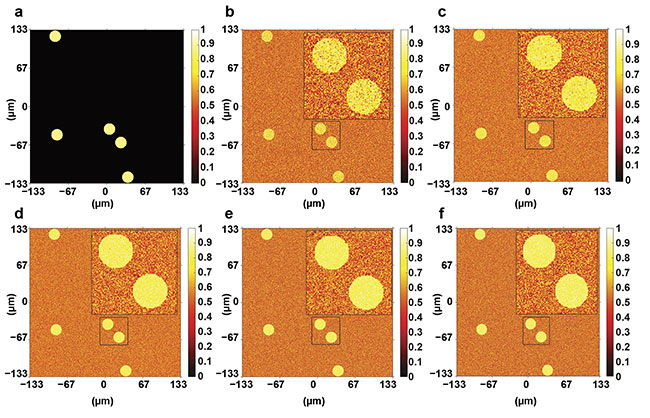The hologram design captures spatial accuracy in the neural network, opening the door for portable optogenetic devices.
DIMITRIS AMPELIOTIS, IONIAN UNIVERSITY; AND ANASTASIOS TSAKAS AND DIMITRIS ALEXANDROPOULOS, UNIVERSITY OF PATRAS
Demystifying the complexity of the human brain is one of the last frontiers in diagnostics and therapeutics. When the brain is sufficiently understood by clinicians, the benefits for human well-being — in the form of cures and treatments for neurodegenerative diseases — will be profound. Such knowledge, gained by using sophisticated illumination patterns in conjunction with artificial intelligence (AI) and advanced algorithms, could forever change the way that medical treatment for many conditions is dispensed.

Courtesy of istock.com/Mohammed Haneefa Nizamudeen.
Optogenetics, in which light-sensitive proteins are introduced into specific brain cells to monitor and control activity, holds promise to deliver results that other traditional brain research methods have not been able to. The technique allows unprecedented specificity and spatial accuracy in activating and monitoring neurons, in the context of the vast networks contained within the brain, thus enabling the ability to visually link neurons to specific tasks, as well as to specific external stimuli that prompt certain behaviors.
How optogenetics works
Optogenetics involves a two-step method. First, light-sensitive opsins are expressed on neurons, which has the effect of making the neurons light-sensitive as well. Second, when these opsins are illuminated, they allow ions to enter the nerve cell, creating a potential difference that acts as stimuli for the neuron. When specific neurons are stimulated, a wide range of research surrounding the function or dysfunction of activity and behavior within the brain can be performed and analyzed.
In a project called Holobrain, which is supported by the National Institutes of Health BRAIN Initiative, nearly 11 laboratories spanning six institutions are using patterned neuronal stimulation technology to map out the links between neural activity in the visual, olfactory, and auditory systems and animal behaviors.
The overall spatial accuracy of patterned stimulation in optogenetics is determined by the accuracy in expressing opsins on neurons, and by the ability of the illumination engine to deliver light in small volumes. Currently, optical setups created to perform optogenetics are bulky and usually not portable. Progress made in integrating multiple photonics technologies into a single system, however, may soon lead to the development and commercialization of a portable optogenetic device that is small and lightweight enough to be implanted in or placed on the skull (Figure 1).

Figure 1. An illustration of an implantable optogenetic device. Courtesy of University of Patras.
The range of illumination delivery options available for systems designers ranges from single-point illumination to multipoint holographic illumination, depending on the neural activation required. The recent scientific literature on illumination for optogenetics has revolved around experimenting with holographic illumination more than with any other illumination delivery method. Such research has particularly shown that phase holograms are the most efficient and versatile form of illumination, since they allow various abstract illumination patterns. It has been shown that computer-generated holograms that can be loaded on a spatial light modulator (SLM) can, in principle, illuminate neurons or groups of neurons of any kind of geometry.
Although such advanced holographic illumination is possible, the actual practice of the technique is limited by the functionality of the apparatus used, in terms of performance and footprint (Figure 2). For example, a large SLM with high pixel count will provide plenty of phase information for hologram reconstruction, but at the expense of the system’s bulkiness. Likewise, a few-pixel SLM can be integrated into a system, but it will reconstruct the holograms with a loss in spatial specificity.

Figure 2. An optical path for hologram design. SLM: spatial light modulator. Courtesy of University of Patras.
For an example of how these developments are playing out for potential use in health care, initial research results suggest that the development of new revolutionary Parkinson’s treatments, enabled by optogenetics, is possible1. Additionally, the combination of efficient illumination algorithms, methods that monitor movement in patients with Parkinson’s, and AI algorithms in a closed-loop control-type model may offer new ways to stabilize gait and balance in these patients.
Optimization algorithms
The aforementioned trade-offs in system functionality help to clarify priorities when designing advanced holograms: It is possible to compensate for a small number of pixels while retaining the benefits of the small footprint, by using an approach based on advanced optimization algorithms.
It therefore becomes important to devise methods for designing accurate computer-generated holograms. This can be accomplished by using discrete-level phase-shifting masks that capture both phase and amplitude information, since such masks can be used in ferroelectric SLMs. These masks are characterized by significantly faster response times compared to the more common liquid crystal-based SLMs.
This approach, however, faces challenges similar to those encountered in other lithography applications. In standard photolithography, or even in electron beam lithography, there are constraints on the number of discrete depth levels that can be fabricated. This limitation translates to the requirement of using few-level phase-shifting masks, since continuous phase levels cannot be used in lithography.
In particular, a plethora of approaches exists for optimizing the use of both continuous and discrete variables. These include branch-and-bound and simulated annealing algorithms, iterative algorithms, and projections onto convex sets, to name a few. However, gradient-based optimization algorithms have also been developed that, in general, are less computationally intensive, require less complex hardware and software, and are more adaptable to portable optogenetic devices.
While most previous published works on the problem of discrete-level phase-shifting mask design have mainly concerned lithography applications, researchers have recently begun to publish work about the challenges of such a design as it relates to optogenetics applications2. In the design requirements for phase masks, similarities exist between lithography applications and optogenetics applications, in the sense that a phase-shifting mask with limited phase must be designed for both types of applications.
The challenges of discrete-level phase-shifting mask design in optogenetics applications can be addressed using a gradient-based regularized optimization approach, which updates the hologram phase mapping iteratively. In particular, performance gains can be obtained by properly modifying the proposed regularization term3. These gains come at a cost, since the regularization term is nondifferentiable and therefore more elaborate, and, thus, optimization algorithms must be employed. One solution is to use the subgradient method to tackle the nonsmooth regularization term4. Another solution involves using a form for the regularization term that is easier to handle analytically, and, subsequently, to use a proximal gradient-type5 algorithm for the minimization.
Figure 3 shows the resulting illuminations achieved by various approaches. All of the results assume the use of an SLM with two phase levels. Additionally, the square regions have been magnified to better demonstrate the results. These results show that the more elaborate optimization approaches1,3 lead to more accurate illumination, with less speckle noise.

Figure 3. Indicative holographic illumination results. The desired response intensity (a). Nonregularized optimization followed by simple quantization to two phase levels (b). The regularized optimization for various regularizer parameters, as described in Reference 2 (c-f). The square regions have been magnified to better demonstrate the results. Courtesy of University of Patras.
Research in the field of optogenetics has advanced to the point that it is now possible to envisage implantable optogenetic devices for therapeutic purposes. Beyond the basic principles of optogenetics that are being extensively researched, realization of an implantable optogenetic device is an engineering challenge that primarily involves miniaturization of the optogenetic setup. Tailored optimization algorithms that can account for device restrictions such as the ones presented can alleviate the computational burden, thus lessening the need for processing power and contributing to a smaller overall size of the optogenetic device. In the future, more research will likely involve optimization algorithms tailored specifically for optogenetics applications.
Meet the authors
Dimitris Ampeliotis is an assistant professor in the Department of Digital Media and Communication at Ionian University in Greece. He is also an associate researcher at the University of Patras. He received a degree in computer engineering and informatics, a master’s degree in signal processing, and a doctorate in signal processing and communications — all from the University of Patras — in 2002, 2004, and 2009, respectively. He has worked on research projects at the Research Academic Computer Technology Institute (RACTI), the University of Patras, the National Observatory of Athens, and the National and Kapodistrian University of Athens; email: [email protected].
Anastasios Tsakas received a bachelor’s degree in materials science in 2017 and a master’s degree in biomedical engineering in 2019, both from the University of Patras in Greece. He is currently a doctoral student working on design issues related to optogenetics in the Department of Materials Science at the University of Patras. Tsakas has worked as a research assistant at the Industrial Systems Institute of the Athena Research Centre, where he used spectroscopic techniques for the early diagnosis of plant leaf diseases. He received a research scholarship from the Biomedical Research Foundation of the Academy of Athens to develop a medical device to monitor hemoglobin concentration; email: [email protected].
Dimitris Alexandropoulos is assistant professor of nanophotonics in the Department of Materials Science at the University of Patras and an affiliated member of the Industrial Systems Institute of the Athena Research Center in Greece. He holds a bachelor’s degree in physics from the University of Athens, as well as a master’s degree in the physics of laser communications and a doctorate in optoelectonics, both from the University of Essex in England; email: [email protected].
Acknowledgments
This research was co-financed by Greece and the European Union (European Social 179 Fund-ESF) through the Operational Programme “Human Resources Development, Education and Lifelong Learning 20142020” in the context of the HOLOGEN project (MIS 5047121).
References
1. J.A. Steinbeck et al. (2015). Optogenetics enables functional analysis of human embryonic stem cell-derived grafts in a Parkinson’s disease model. Nat Biotechnol, Vol. 33, No. 2, pp. 204-209.
2. D. Ampeliotis et al. (2021). Proximal algorithms for discrete-level phase-shifting mask design with application to optogenetics. Photonics, Vol. 8, No. 477.
3. X. Ma and G.R. Arce (2007). Generalized inverse lithography methods for phase-shifting mask design. Opt Express, Vol. 15, pp. 15066-15079.
4. D. Ampeliotis et al. (2021). A regularized optimization approach for optogenetic stimulation using ferroelectric SLMs. Proc SPIE 11875, Optical System Design, Computational Optics Bellingham, Wash.,
www.doi.org/10.1117/12.2599865.
5. N. Parikh and S. Boyd (2014). Proximal algorithms. Found Trends Optim, Vol. 1, pp. 127-239.